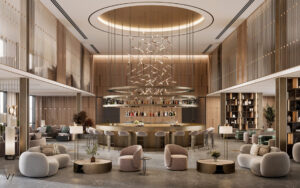
In the heart of the bustling, diverse, and iconic city of San Francisco, where innovation meets culture, stands a collection of hotels that are not just places to stay but experiences in themselves. These hotels are the result of visionary architects who have skillfully blended functionality, aesthetics, and the unique spirit of the city to create spaces that enchant and captivate guests. In this blog post, we will delve into the world of hotel design in San Francisco, exploring how the city’s top architects shape the hospitality landscape.
San Francisco: A Canvas of Diversity
San Francisco is a city of extraordinary diversity. Its neighborhoods each have their own distinct character, from the historic charm of Nob Hill to the vibrant energy of the Mission District. This rich tapestry of cultures, landscapes, and histories serves as the canvas upon which architects paint their designs.
The best architects in San Francisco understand the importance of integrating a hotel seamlessly into its surroundings. Whether nestled amidst the iconic Victorian houses of Pacific Heights or overlooking the glistening waters of the Bay, these architects ensure that every hotel they design pays homage to its location.
Site Selection and Integration
The first step in crafting an exceptional hotel is site selection. Architects in San Francisco meticulously choose locations that offer stunning views, access to local attractions, and a sense of connection to the city’s essence. The site becomes the foundation upon which the entire hotel experience is built.
Take, for example, the renowned Fairmont San Francisco atop Nob Hill. Designed by Julia Morgan, this iconic hotel showcases her genius in selecting a site that provides breathtaking views of the city and the Bay. The Fairmont is a masterpiece of integration, harmonizing with its historic surroundings while offering guests a taste of San Francisco’s opulence.
Blending Modernity with Tradition
San Francisco is a city that embraces both its rich history and its forward-thinking spirit. The best architects recognize the importance of striking a balance between the past and the future when designing hotels.
The Ritz-Carlton, San Francisco, designed by Hornberger + Worstell, is a prime example of this blend. Housed in a historic 1909 neoclassical building, the hotel seamlessly combines the architectural grandeur of the past with modern luxury and amenities. The result is a space that exudes timeless elegance while meeting the demands of contemporary travelers.
Sustainable Design
In a city known for its commitment to sustainability, the best architects prioritize environmentally conscious design. San Francisco’s hotels are no exception, with many architects incorporating sustainable elements into their projects.
The InterContinental San Francisco, designed by Patri Merker Architects, is a LEED-certified hotel that exemplifies this commitment to sustainability. It features energy-efficient systems, green roofs, and a rainwater harvesting system. Such initiatives not only reduce the hotel’s environmental footprint but also enhance the guest experience by fostering a sense of responsibility towards the planet.
Maximizing Space Efficiency
San Francisco’s architectural landscape is characterized by its limited space. The city’s top architects are experts at making the most of every square foot available, ensuring that hotel guests enjoy both comfort and functionality.
The Virgin Hotels San Francisco, designed by Gensler, is a prime example of space efficiency. Located in the heart of SoMa (South of Market), this hotel offers compact yet well-designed rooms that cater to the needs of modern travelers. It’s a testament to the architects’ ability to create a luxurious experience within a limited footprint.
Creating Unique Experiences
Exceptional hotels are not just places to sleep; they are destinations in themselves. San Francisco’s architects are skilled at designing spaces that provide guests with unforgettable experiences.
The Clift Royal Sonesta Hotel, designed by Philippe Starck, is a striking example of this concept. Starck’s design blurs the lines between art and hospitality, featuring a whimsical and surreal interior that invites guests to explore and discover. Such unique and immersive designs elevate the hotel experience to a whole new level.
The Importance of Public Spaces
Hotels in San Francisco are more than just rooms; they are communal spaces where guests can connect and engage with the city and its residents. The best architects understand the significance of these public spaces.
The St. Regis San Francisco, designed by Skidmore, Owings & Merrill, boasts a stunning lobby that serves as a hub for social interaction. With its soaring ceilings, modern art installations, and comfortable seating areas, it’s a place where guests can unwind, work, or simply people-watch. The lobby becomes an extension of the city itself, a place to experience San Francisco’s vibrancy.
Conclusion
San Francisco’s top architects have played a pivotal role in shaping the city’s hospitality landscape, creating hotels that are not just places to rest, but destinations that embody the essence of this dynamic city. They understand that exceptional hotel design involves site selection, a balance of tradition and modernity, sustainability, space efficiency, unique experiences, and the creation of inviting public spaces. These architects have left an indelible mark on the city, ensuring that every guest’s stay in San Francisco is a memorable journey of exploration and discovery.
As San Francisco continues to evolve, one can only look forward to the future creations of these visionary architects, each one destined to be a masterpiece in its own right, a testament to the enduring marriage of innovation and heritage that defines this remarkable city. Whether you’re a visitor or a resident, the best San Francisco architects ensure that every stay in the city is an unforgettable experience, where the art of design meets the heart of hospitality.

